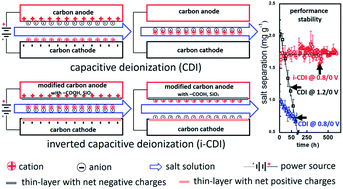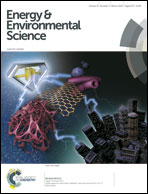Surface charge enhanced carbon electrodes for stable and efficient capacitive deionization using inverted adsorption–desorption behavior†
Abstract
Unsustainable and inefficient capacitive deionization (CDI) performance has been observed through CDI operation with carbon xerogel (CX) electrodes for 50 hours using a constant-voltage charging method. This behavior is primarily accounted for by changes in the surface chemistry for the studied material via oxidation of the carbon electrodes in an aqueous solution. In order to improve performance stability, we have developed a novel CDI system using an anode with net negative surface charges and a cathode with net positive surface charges. As a result, salt separation in this system is achieved in an opposing manner to the conventional CDI system, e.g., when the system is charged using a power source, cations and anions are desorbed at the anode and cathode, respectively. This system is named the inverted capacitive deionization (i-CDI) system. Most importantly, salt separation in the i-CDI system was maintained for over 600 hours, which is approximately an increase of 530% in lifetime compared to a CDI system operated under similar conditions. This enhanced performance stability is attributed to the use of oxidized anodes in the i-CDI system, which limits the possibility for loss in separation performance due to carbon oxidation in an aqueous solution.


 Please wait while we load your content...
Please wait while we load your content...